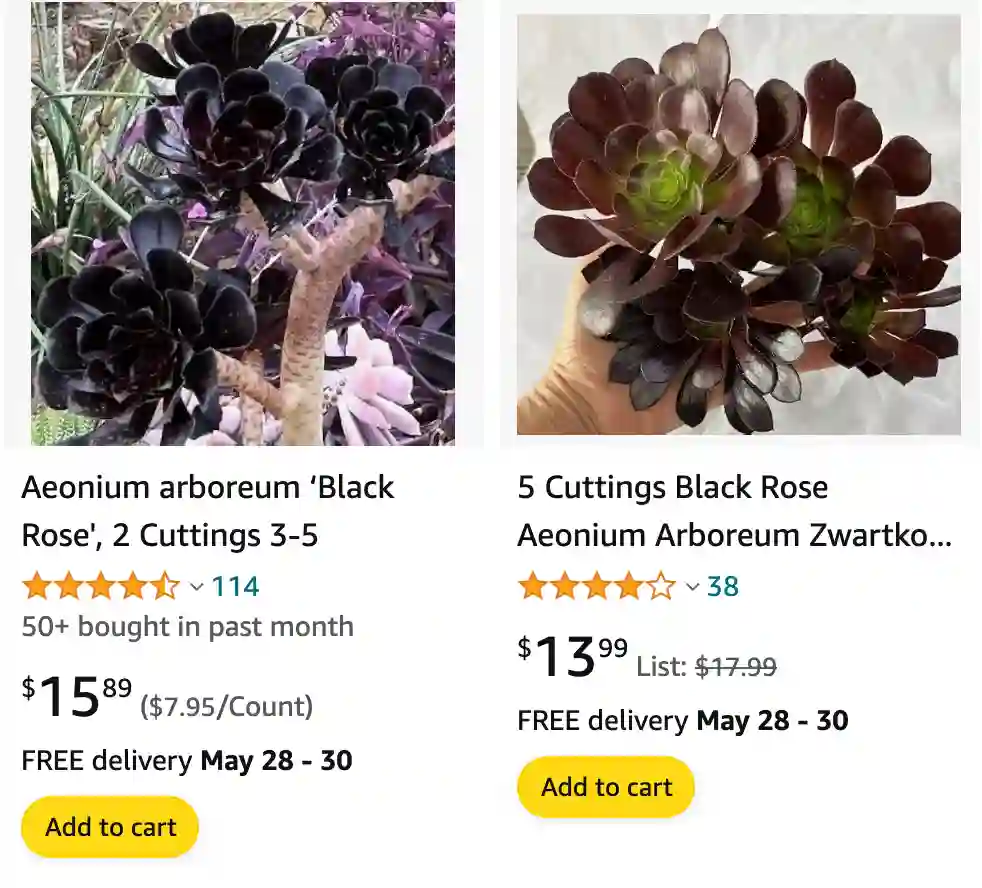
How to care for Aeonium Black Rose?
The Aeonium Black Rose, known for its stunning dark rosettes, thrives with proper care. Here’s a guide to keep it flourishing:
Light:
- Bright, Indirect Sunlight: This succulent prefers bright, indirect sunlight for at least 5-6 hours daily. Too much direct sun, especially during harsh summer afternoons, can scorch the leaves.
- East or South Facing Windows: Placing your Aeonium Black Rose near an east or south-facing window can provide ideal lighting conditions.
Watering:
- Soak and Dry Method: Avoid overwatering, which is detrimental to succulents. Use the soak and dry method: water deeply until excess water drains from the pot’s drainage holes, then allow the soil to dry out completely before watering again.
- Frequency: Watering frequency depends on factors like pot size, climate, and season. Generally, water more frequently during hot weather (every 1-2 weeks) and less often in cooler months (every 2-3 weeks).
Soil and Potting:
- Well-Draining Mix: Use a well-draining succulent or cactus potting mix. You can also create your own mix by combining potting soil, perlite, and sand in equal parts.
- Drainage Holes: Ensure the pot has drainage holes to prevent waterlogging.
Temperature:
- Warm Temperatures: Aeonium Black Rose prefers warm temperatures between 65-75 degrees Fahrenheit (18-24 degrees Celsius).
- Winter Protection: While it tolerates some light frost, protect it from freezing temperatures, especially if young or recently planted.
Humidity:
- Average Humidity Levels: Aeonium Black Rose tolerates average household humidity levels. Higher humidity can be beneficial, but excessively moist environments can promote fungal issues.
Fertilizing:
- Light Feeding: This succulent is not a heavy feeder. A diluted, balanced liquid fertilizer applied once during spring or early summer is sufficient. Avoid overfertilizing, which can cause leggy growth.
Additional Tips:
- Deadheading: Remove spent blooms to encourage bushier growth and maintain a neat appearance.
- Rotation: Rotate your Aeonium Black Rose occasionally to ensure even growth on all sides.
- Pests and Diseases: Generally pest and disease resistant, but watch out for mealybugs and scale insects. Treat them with insecticidal soap or neem oil if necessary.
- Repotting: Repot your Aeonium Black Rose only when the roots outgrow the current pot, typically every 2-3 years. Choose a pot that’s only slightly larger than the root ball.
How to propagate Aeonium Black Rose?
You can propagate your Aeonium Black Rose using two main methods: stem cuttings and leaf cuttings. Here’s a guide for each method:
Propagation by Stem Cuttings:
- Selecting the Cutting: Choose a healthy, mature stem with at least a few sets of leaves. Ideally, it should be around 3-4 inches long.
- Making the Cut: Use sterilized pruning shears or a sharp knife to make a clean cut just below a leaf node (the bump where a leaf joins the stem). You can also cut off the top of the main stem if desired, to encourage branching on the remaining plant.
- Callousing the Cutting: Allow the cut end of the stem to callous over for a few days. This helps prevent rot when planting. Leave it on a dry, well-ventilated surface out of direct sunlight.
- Planting: Prepare a pot with well-draining succulent or cactus potting mix. Moisten the soil slightly. Make a small hole in the soil and insert the calloused end of the cutting.
- Aftercare: Water the soil lightly and place the pot in a location with bright, indirect sunlight. Avoid overwatering, and keep the soil mostly dry between waterings.
Propagation by Leaf Cuttings:
- Selecting the Leaf: Choose a healthy, plump leaf from the lower part of the plant.
- Removing the Leaf: Gently twist or pull the leaf downwards to remove it from the stem, taking care not to damage the leaf base.
- Callousing the Leaf: Allow the leaf to callous over for a few days, similar to stem cuttings. Lay it flat on a dry, well-ventilated surface out of direct sunlight.
- Planting: Prepare a pot with well-draining succulent or cactus potting mix. Moisten the soil slightly. You can lay the leaf flat on the soil surface, with the base of the leaf slightly touching the soil, or wedge the base of the leaf slightly into the soil.
- Aftercare: Water the soil very lightly and place the pot in a location with bright, indirect sunlight. Avoid overwatering, and mist the leaves occasionally to maintain humidity, especially in dry climates.
General Tips:
- Propagate your Aeonium Black Rose during the spring or summer growing season for best results.
- Maintain consistent warmth around the propagating plantlets.
- Be patient! It can take several weeks for roots to develop and new growth to appear.
- Once new growth emerges from the stem or leaf base, you can care for the new plantlet like a mature Aeonium Black Rose.




